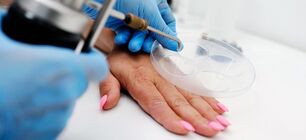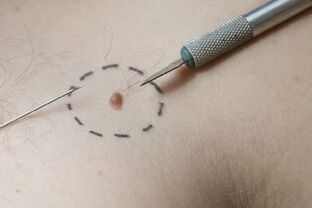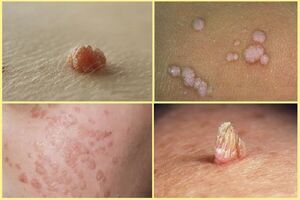Warts are benign skin and mucous membranes that occur due to the activation of the human papilloma virus.
They do not look aesthetically pleasing and often cause complexes. A person wants to get rid of them, but doesn't know how.

Should we remove the creation?
It depends on the size, nature of papillomas and age of the person. Often times, however, the answer is definitely positive, as warts are contagious and can infect others. Perhaps self-infection is also autoinoculation.
Firstly, the contagiousness of neoplasms is manifested not only through direct contact with them, but also by using ordinary household items, personal hygiene items, or simply touching the places that an infected person has touched. For example, a bus guardrail.
Secondly, the localization of the wart can be where the injury is most likely - neck, feet, armpits, groin. These places are rubbed, squeezed and touched with clothing more often than others. Then it is fraught with malignancy, bleeding, overgrowth.
Third,occurrences may increase in size and number, causing aesthetic problems. This phenomenon can be called the conquest of the area by a wart.
Important! Not always, perhaps the degeneration of a wart, melanoma, an incurable, aggressive skin cancer.
Basic misconceptions about the danger of surgery
Early treatment and treatment of warts is the best option. It will save you a lot of time, effort and money. Although 70% of warts disappear spontaneously after 2 years from their existence, they can return to new places with the same success.
It is associated with the fear of many people who come into contact with the surgeon, fear of surgery, complications, relapses and possible pain during the procedure. Modern methods are completely baseless as they provide very good pain relief and most do not require anesthesia.

There is still a widespread opinion that touching the wart extra with a surgeon's blade will increase its growth. This is the deepest misconception - it is surgical intervention that will prevent the spread of the virus and prevent the wart from growing. Fortunately, there are enough methods for this.
Strange can be called patients who are not afraid to use traditional home-grown methods and refuse qualified assistance. The experience and qualifications of a doctor are of course very important, but a good surgeon is not uncommon.
And one more help - do not trust beauticians and run to them with warts. They just don't have adequate medical training.
Modern Methods
There are newer or older removal methods. Each has its own advantages and disadvantages. In addition, the effect depends on the size of the wart, its location, and the depth of growth.
All methods can be divided into 3 groups: hardware, surgical, and chemical. Alternative treatment is more related to the physical (mechanical) effect method.
When you contact the doctor, the doctor may suggest the best option for him, but the patient himself makes the final choice.
A pre-consultation is also required, as not all methods you choose may be suitable as there are contraindications and limitations.
Laser Treatment
Thelaser method can be called universal. It leads the way among all methods today. With the help of laser, you can remove warts in the most difficult, sensitive and painful places. It is also advantageous in terms of leaving no traces. Ray is the safest and least traumatic.

The efficiency is so high that one procedure is sufficient. The essence of the thermal effect on the wart is that it burns with heat. Recovery is rapid, there are no scars and complications.
More laser pros:
- patient does not feel pain;
- anesthesia is not required;
- has been completely removed;
- fast - takes 1-2 minutes. Relapses are possible in only 20% of cases.
Burn leaves a fossa that heals in 2 weeks. The skin may be temporarily opened and this will pass spontaneously after 3 weeks.
Liquid nitrogen cauterization
Kriiodestruction is the freezing of a wart using liquid nitrogen at low temperatures. Duration - 30 seconds. Freezing leads to the death of growth tissue. When exposed to frost, the papilloma thickens and turns white. After a minute, it turns red and swollen.
A gray bubble of liquid will appear in the house. It will split on its own within a week and a crust will form. The shell heals and falls off within 2 weeks.
A pinkish speck remains, its color gradually becomes equal to the skin color. The formation disappears within 2 weeks and a pinkish spot appears where it was removed, which gradually disappears.

Pros:
- no pain, no scars and no anesthesia required;
- No infections or bleeding.
The only downside is that there is no way to control the depth of the impact.
The effect takes about 1 minute on the soles of the feet. The process can be repeated up to 5 times at the base. Minus - long wound healing.
Electrocoagulation
Electrocoagulation for warts uses high frequency currents. It concentrates in a cycle that cuts the wart. The plaster temperature is about 80 degrees.
No bleeding due to simultaneous coagulation of blood vessels. Local anesthesia is required. A big advantage of the method is that it prevents the further spread of the virus. In addition, the method is quite budget and effective.
The surrounding tissue should be covered and the skin should be disinfected. There is also a crusting stage. It disappears within a week. After that, an almost imperceptible transparent scar remains, but rather a light stain. No repetition!
Radio wave therapy application
Themethod is considered to be no less effective than electric current. Plaster is made using special devices, a doctor will help you choose the right one. This is a radio wave generator, high frequency electric waves do not touch the wart, they cut it completely.

The essence of the action is that the wart cells contain fluid that expands by radio waves, swelling and bursting of the wart. The work is done with a special nib that looks like a ballpoint pen.
No scars or infections. The only drawback is the pain of the procedure, so the build-up is pre-lubricated with an anesthetic. Healthy cells are not damaged. The patch takes about 20 minutes.
Recommended! It cannot be wetted and peeled off at the shell stage! It disappears within a week.
Surgical excision
Surgical removal is a traditional, classical method performed with a scalpel. It is not used often now. The method is traumatic and gives relapses, scars.
Risk of damage to adjacent tissues, possible infection. However, if the wart is large, it cannot be replaced. After the incision, the wart is scraped with a special spoon under local anesthesia. The stitches are cosmetic, they are removed after a week. The scar remains approximately 3 mm in size and disappears over time.
Chemical fuel
The formation is affected by an acid or an alkali. Wash it off after a certain time. There are usually at least 6 procedures to achieve the effect. Meanwhile, there is a burning sensation or tingling sensation. The wart dries up and falls off.

Disadvantages:
The- virus has a higher risk of spreading and the infection is not ruled out;
- healthy tissue is often damaged;
- scars are possible, healing takes approximately 10 days.
method is used only if other methods are impossible.
Advantages and disadvantages of different methods, which one is better
Any removal method has its pros and cons, there are no ideal options. The most popular methods today are: laser therapy, cryotherapy, electrocautery, radio waves, surgical scalpel - in descending order of use. The cost of the first 3 methods is actually in the same price range.
TheLaser is the first pioneer: there is no inaccessibility, it is safe, fast and painless. Cryodestruction is considered the second most effective, however, there is no possibility to control the depth of exposure, since relapses are possible.
And one more result - laser can only remove 1 small formation in 1 session.
Cryotherapy is applicable for papillomatosis, when up to 40 growths can be removed in 1 procedure. However, here the doctor's experience is of great importance for quality.
How does the location and type of growth affect your choice of technique?

There are 4 types of warts:
- coarse- grows in the form of small bumps, usually on the fingers and toes, behind the hands;
- flat- typical for adolescents, they are protruding points; these are plantar (thorns);
- thread-like (acrocords)- elastic thin projections on the leg, face (eyelids, lips) and neck;
- genital warts - usually localized on the mucous membranes of the genitals; resembles cauliflower in appearance.
These 4 types are of viral origin and belong to true warts.
However, there are also senile keratomas caused by functional disorders in the skin. It does not require treatment, only observation. Cryotherapy can be used if desired.
The doctor recommends a removal method, but ultimately the patient chooses. The choice of method depends on the type of wart: Small formations can be safely removed with aradio wave "knife" or liquid nitrogen.
TheRadio Knifecan be used on the face and neck, feet and palm and groin areas. It is not used with papillomas on the eyelids. They can use a laser or liquid nitrogen.
Ice creamis also used on arms and feet (base), neck papillomas. The cryo method can be called universal. Safe.
Laser- Removes warts on any part of the body, including under the nail.
Surgical methodis used for large growths of the oral mucosa.
Electrocoagulationis recommended for flat and coarse warts. It can even be applied to the face. In large formations the effect is insignificant. Also, the electric knife is not used for plantar warts because they usually have deep roots and are very dense.
Important! It is recommended that plantar growths be hospitalized only.
The chemical method gives good results in straight and pointed plantar lesions. Physical methods are ineffective for him.
What method do doctors recommend to eliminate formations?
Of course the client chooses according to his abilities. However, the correct decision should be guided by the doctor's opinion. Specialists prefer the complex (combined) treatment of warts, for which the leading place belongs to removal.
In addition, treatment will include oral administration of drugs with antiviral activity. Although HPV virus (human papilloma virus) is not 100% cured and in many ways its activation is dependent on the immune state, it can be slowed down, "sleepy" and remission prolonged.
In addition to antiviral drugs, immunomodulators are used for this purpose. This is, first of all, an interferon group.
Since the treatment is not done by doctors and it will not be safe, doctors use folk methods without much enthusiasm. It is fraught with damage to surrounding tissues, infection, inflammation. Children under 5 years old should not remove warts in any way.














































































